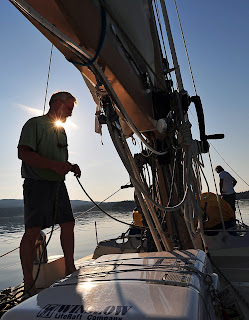S'COOL Sets Sail To Promote Ocean Health

 A NASA program that has inspired children to study clouds on every continent but Antarctica has set sail to conquer new frontiers -- the oceans.
A NASA program that has inspired children to study clouds on every continent but Antarctica has set sail to conquer new frontiers -- the oceans.The Students Cloud Observations On-Line (S'COOL) program at NASA's Langley Research Center in Hampton, Va., is teaming up with the Pacific Science Center and Sailors for the Sea for a 25,000-mile (40,234 km) sailing journey to raise awareness about the health of the world's oceans. The boat departed from Seattle early last week and the crew intends to sail all the way around North and South America. They head north first, and will take advantage of the drastic decline in summer Arctic sea ice to make around northern Canada -- the famed Northwest Passage, a route that's rarely been followed but is becoming easier because of the dramatic loss of summer sea ice in the Arctic.
Along the way, the crew of sailors and scientists on the 64-foot (19.5 m) vessel Ocean Watch will be taking measurements for eight different scientific endeavors while blogging about their trip and stopping at key ports to talk to people about the oceans. The trip will include stops in Resolute, Canada, one of the coldest places on Earth with a permanent human presence, and Puerto Williams, Chile, one of the southernmost cities in the world.
S'COOL works as both an educational tool for students and a validation tool for scientists with the Clouds and the Earth's Radiant Energy System (CERES) satellite-based instruments. CERES measures the Earth's energy balance, the ever-changing flux of incoming and outgoing radiation that governs the climate. CERES makes mostly accurate observations of clouds, which play a key role in the energy balance, but S'COOL students offer a second opinion on those measurements. With S'COOL, a class of students goes outside at a given time and observes the type and number of clouds in the sky at that time, to correspond with CERES passing overhead. The students' observations are used to "ground-truth" what CERES recorded.
The program has expanded from an association with several schools near Langley Research Center to involve participants from more than 1,000 schools worldwide in the 12 years since its inception. S'COOL is growing in popularity in South America, and is particularly popular on that continent in Argentina, Chile and Colombia. The observations from the four-man Ocean Watch crew will mark the first time that cloud observations have been collected consistently from the open ocean for S'COOL. Students who want to follow the expedition can make their own observations and compare with Ocean Watch by using the S'COOL Rover Web site.
"This is a unique opportunity for S'COOL to get a collection of observations from sites in the ocean, as well as from interesting and remote locations along the Northwest Passage and other portions of the voyage," said S'COOL project manager and NASA Langley climate research scientist Lin H. Chambers.
In 31 scheduled ports of call along the 13-month voyage, the crew and other visiting scientists and ocean-related professionals will set up an open house for the public to visit. The trip's goal is to highlight threats to the oceans such as unsustainable fishing and climate change-related concerns such acidification caused by too much carbon dioxide in the water, which is destroying fragile coral reefs, and the loss of Arctic ice.
"North and South America are surrounded by a large, complex, and frighteningly fragile ocean environment -- and these oceans are changing in large part as a result of human activity," said David Rockefeller Jr., Sailors for the Sea founder. "The goal of this expedition is to build broad awareness among everyday citizens of the precipitous changes occurring throughout the world's oceans and the impact these changes have on various ecosystems and human life."
Science projects on-board, in addition to S'COOL, include a survey of jellyfish, which are being seen in blooms in coastal waters thought to be an effect of stress on oceans as a result of climate change. The crew will also deploy a buoy in the Arctic ice that measures air pressure and sea surface temperature. Its location, along with a fleet of other buoys, can be tracked by satellite to provide information on ice movement. Scientists affiliated with the voyage will also: collect fundamental oceanographic data such as seawater pH and temperature; deploy a hydrophone to record marine mammal sounds; study the frequency and occurrence of whitecaps to evaluate how breaking waves play a role in the air-sea transfer of heat and energy and produce natural aerosols; and use a hand-held photometer to study solar reflection by aerosols, data not typically collected at sea that will be used to ground-truth NASA satellite measurements.
But perhaps the most striking facet of the journey is the plotted route. The crew will have a short window of time in mid August to make the once-fabled, now real Northwest Passage. The warming Arctic and declining summer ice make this possible. The idea of a North and South America circumnavigation as an awareness tool was made all the more powerful by the ability to take a route that didn't exist, as open water, not so long ago.
"Ten years ago this wouldn't have been possible," said Kris Ludwig, an oceanographer and project manager at the Pacific Science Center who is helping coordinate the Around the Americas trip. "They hear 'Northwest Passage' and at first people say, 'That's really cool!' Then it dawns on them. You can see the change on their face."



 9:44 PM
9:44 PM
 sheldon
,
sheldon
,















0 Response to "S'COOL Sets Sail To Promote Ocean Health"
Post a Comment